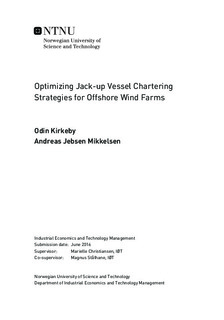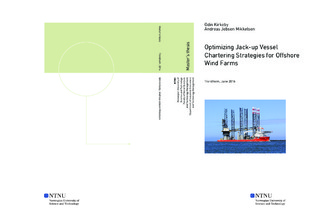| dc.description.abstract | Offshore wind energy is an industry in rapid growth. However, it is still outperformed by conventional sources of energy in terms of costs. One way to cut costs is to make operations and maintenance (O&M) more efficient; O&M costs can constitute up to one third of overall lifetime costs for an offshore wind farm. Jack-up vessel chartering represents a significant part of these costs. This creates a demand for effective chartering strategies for the jack-up vessel.
Two stochastic models considering uncertainties in weather and turbine component failure occurrences are presented in this thesis. The models suggest chartering schedules for the jack-up vessel based on electricity prices, charter rates, mobilization costs and failure and weather scenarios. The schedules contain information about when and for how long the vessel should be chartered.
Due to the complexity of the studied problem, exact methods were insufficient and the Sample Average Approximation (SAA) method and heuristics are proposed. The SAA method solves a number of smaller problems in order to provide optimistic and pessimistic bounds for the optimal objective value of the true problem. The idea behind the heuristics is to create sequences of maintenance operations using a greedy approach. The most successful heuristic also has a random component.
When solving the jack-up chartering strategy problem, the combination of the SAA method and a greedy, randomized heuristic proved to be successful. The SAA method helped reduce computational complexity, and in combination with the heuristic, provided tight bounds for the optimal objective value.
It was found that for wind farm sizes ranging from 50 to 100 turbines, the costs of chartering the jack-up vessel dominate turbine downtime costs. This points towards an imbalance in the jack-up vessel charter market where demand is higher than supply, driving prices up. Analyses show that charter prices are at a level such that buying a vessel should be considered when wind farm size exceeds about 71 turbines.
Solving the stochastic jack-up vessel chartering strategy problem can provide useful insights for offshore wind farm operators and jack-up vessel owners. This is illustrated by analyses of whether chartering of buying a vessel is most economically sensible for different wind farm sizes. Moreover, the models can provide information about the value of having a more weather robust vessel. | |

